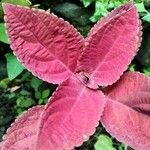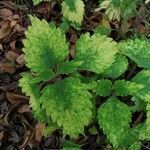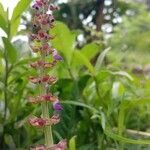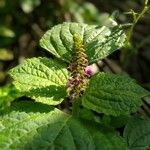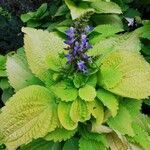Erect or ascending branched herb, 0.5-1.5 m, aromatic, without tubers. Stem and branches finely pubescent or glabrous. Leaves membranaceous, very variable in size, shape and colour, generally ovate in outline, blade 1-15 (usually 4-7) by 1-10 (usually 3-5) cm, acute or acuminate, base rounded or cuneate, entire, margin elsewhere crenate, serrate, remotely crenate or sometimes laciniate, pubescent on the main and secondary veins; petiole 1—5(—8) cm. Flowers in verticillasters or in irregularly branched cymes disposed in simple or branched thyrses 5-10(-25) cm long, 3-5(-8) cm Ø; peduncles of the lateral cymes short or elongated. Bracts ovate-acute, pubescent, 2-3 mm long, caducous. Calyx obliquely campanulate, 10-nerved, 2-2.5 mm long, in fruit 4-6 mm, hirsute and sparingly gland-clotted, unequally 5-toothed; upper tooth broadly ovate, subacute; two lateral teeth very short, oblong-obtuse, truncate or rounded, occasionally mucronate with a tiny apiculate apice; two lower teeth subulate, connate. Pedicels 3-4 mm, pubescent. Corolla boat-shaped, blue or violet, with whitish tube, upper lip often paler than the lower one, 8—13 mm long (rarely 15-18 mm in some Papuan specimens), puberulent, tube abruptly decurved, upper lip short, erect, lower lip long, concave, enclosing the stamens and most of the style. Stamens in 2 pairs; filaments connate beyond the point of attachment to the corolla tube. Nutlets broadly ovate or orbicular, brown, shining, 1-1.2 mm long.
More
A herb. It grows 50-150 cm tall. The young stems are hairy. The leaves are opposite. The leaf stalks are 1-4 cm long. The leaf blade is 2-15 cm long by 2-10 cm wide. There are blunt teeth around the edge. The leaves are usually coloured with red or white markings. The flowers are blue to purple and 1 cm across.
On all sorts of habitats from the lowland to the mountains, in rainforest, along shaded stream-banks and other watercourses, on rice-field dykes, in thickets, in Malaya also on limestone hills, in secondary forest, mossy forest, etc. up to c. 2900 m. Fl. Jan.-Dec.
More
Various habitats from the lowland to mountains; growing in rain-forest; shaded stream-banks and other watercourses; rice-field dykes; thickets; limestone hills; secondary forest; mossy forest, disturbed ground etc; at elevations up to 2,900 metres.
It is a tropical plant. It can grow from the lowlands to the mountains. It can be in rainforest and along shaded stream banks. It grows up to 2,900 m above sea level. It needs a hardiness zone above 11.
Uses. Except cultivation for ornamental purpose this species is also assumed to have medicinal use. BURKILL ( BURKILL Dict. 1935 635 ) says it is employed for dyspepsia and ophthalmia. In Java and Sumatra it is used as an abortivum and also as a repellent for intestinal worms. In the Philippines sometimes used for head-aches and bruises. In Java many minor uses, see HEYNE Nutt. Pl. 1927 1334 .
More
The leaves are eaten cooked with meat. Caution: It is considered to induce abortions. The fresh leaves when chewed may cause mind altering effects. The tubers are eaten.
